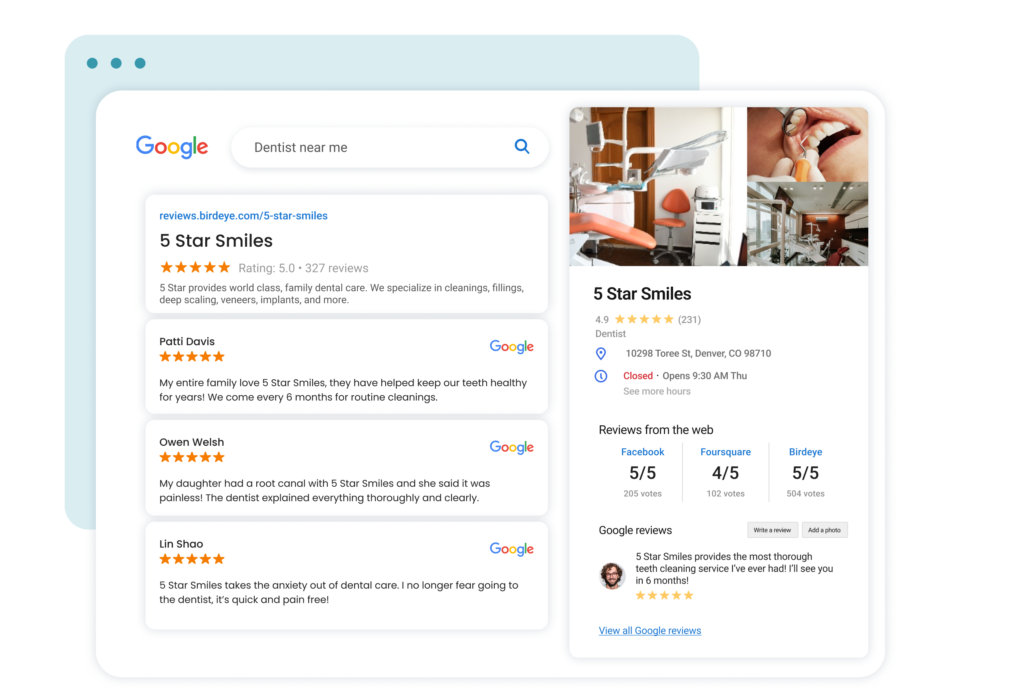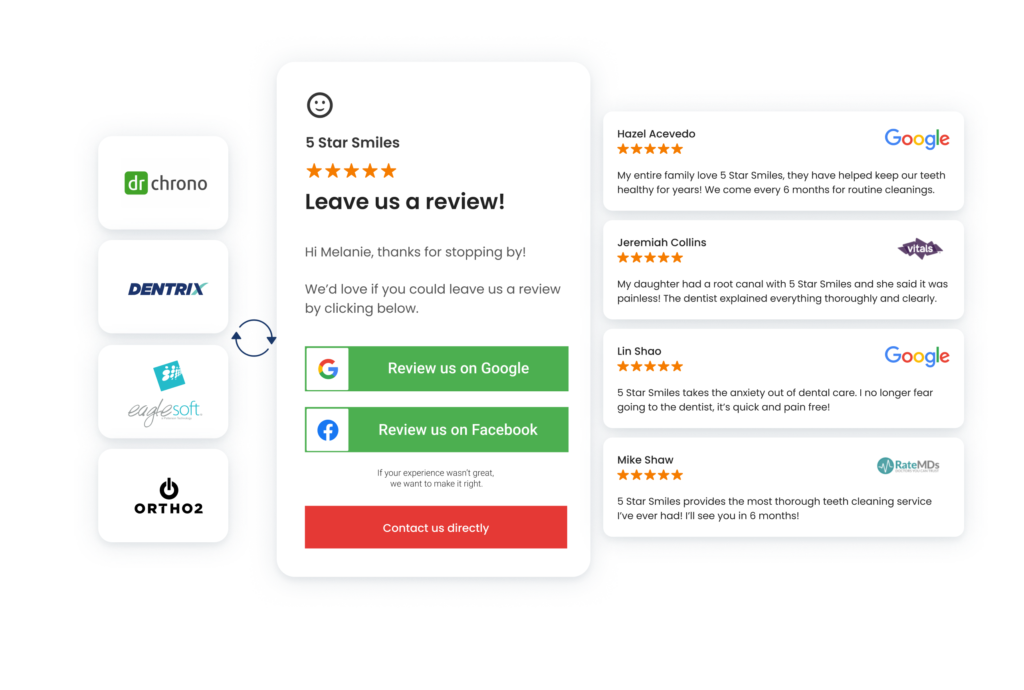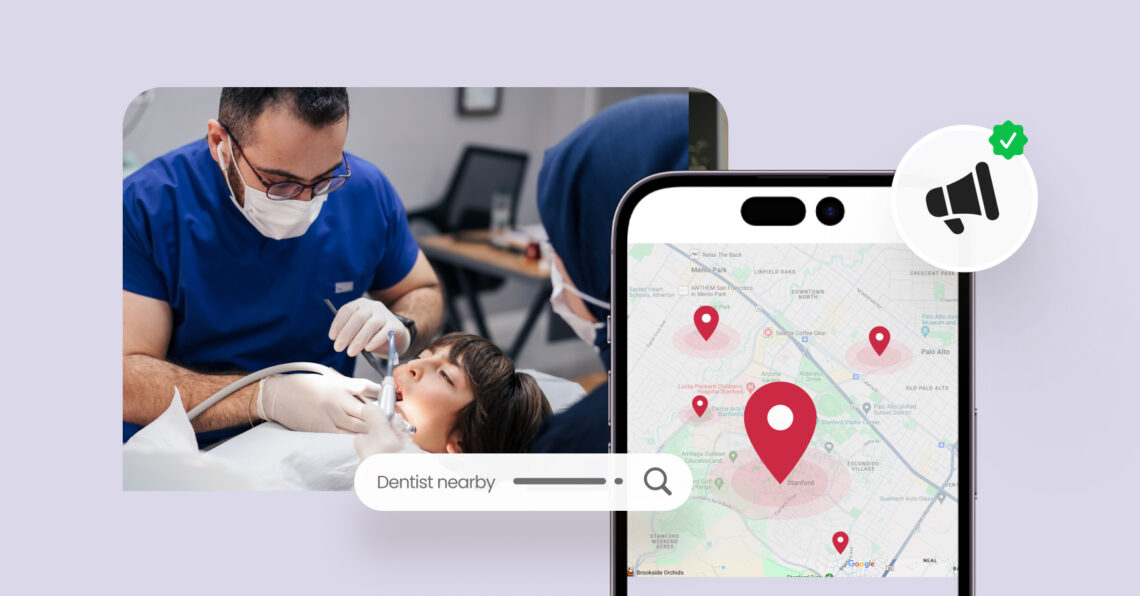Local SEO for dentists helps determine whether patients in your area find you or the practice down the street. According to ‘The One Study’, 83% of people will ask for recommendations before choosing a dentist, often seeking advice from multiple friends or family members. Yet, 65% trust what they discover in search engines just as much as personal recommendations. That means some people, right now, might be looking for a dentist like you but booking with someone else simply because you didn’t appear at the top of their search results.
Think about it: a new family moves into town, opens Google, and searches “dentist near me.” If your practice shows up first, you’re more likely to get the click, the phone call, and ultimately a new long-term patient relationship. The dental local SEO gives visibility that translates into booked appointments, word-of-mouth referrals, and a steady stream of new patients walking through your door.
Birdeye has found that effective local SEO can significantly improve your dental practice’s visibility and patient acquisition, with some Birdeye clients experiencing a 927% Increase in search views.
This guide will explore practical steps to enhance your online presence, from optimizing your Google Business Profile (previously called Google My Business) to leveraging patient reviews and creating high-quality local content. By the end, you’ll know how to implement dental local SEO strategies to improve your search engine rankings and drive more foot traffic to your practice. Let’s begin.
Table of contents
- What is Local SEO for dentists?
- Why is local SEO crucial for dentists?
- Setting up Google Business Profile (GBP) for dentists
- On-page SEO for dental websites
- Key on-page SEO elements
- Implementing schema markup
- Monitoring and updating content
- Importance of online reviews and how Birdeye can help
- Strategies for managing online reviews
- Best practices for responding to reviews
- Highlighting positive reviews
- Best practices for social media content
- Frequently asked questions about local SEO for dentists
- Maximize your dental practice’s local SEO success with Birdeye
What is Local SEO for dentists?
Local SEO for dentists is a specialized search engine optimization strategy that focuses on improving a dental practice’s visibility in local search results. When someone searches for terms like “dentist near me” or “family dentist in [city],” search engines display practices that are most relevant and nearby.
The goal of local dentist SEO is to ensure your practice ranks well in the Google “Local Pack” (map listings), so potential patients can easily find and contact you.
To achieve this, a local SEO guide for dentists typically covers:
- Optimizing your Google Business Profile to improve visibility in local searches and map results.
- Maintaining consistent NAPW (Name, Address, Phone, Website) information across all directories.
- Building local citations on trusted healthcare and business platforms.
- Gathering and managing online reviews to boost credibility and patient trust.
- Creating location-specific, keyword-rich content that attracts nearby patients.
These strategies help improve search rankings, build trust with patients, and increase appointment bookings within your service area.
Why is local SEO crucial for dentists?
When someone needs a dentist, they usually start by searching online. To make sure your practice appears in those searches, you need to focus on local SEO.
Here’s why it matters:
- Increased visibility: Effective local SEO ensures your practice appears at the top of local search results.
- Qualified leads: It attracts relevant traffic from people searching for dental services nearby.
- Enhanced reputation: Appearing in local searches with positive reviews builds trust.
- Mobile searches: Optimizes your practice for mobile device searches.
Critical elements to guide local SEO for dentists
Here are the key elements every dentist should focus on to succeed with local SEO.
- Google Business Profile optimization: A complete and optimized GBP is essential. Birdeye can help manage and enhance your Google Business Profile.
- Local citations: Ensure consistent information (name, address, phone number) across directories. Birdeye’s listings management can handle this.
- Online reviews: Positive reviews attract patients and improve rankings. Birdeye helps manage and respond to reviews.
- On-page SEO: Use local keywords, create location-specific pages, and ensure your website is mobile-friendly.
- Local content creation: Share content relevant with your community to boost your practice’s visibility.
Implementing SEO for dental office is vital for attracting local patients. Focus on GBP optimization, managing citations, encouraging reviews, and creating local content. Birdeye’s tools can streamline this process, helping your practice stand out in local search results.
Setting up Google Business Profile (GBP) for dentists
Optimizing your Google Business Profile profile is essential for local SEO dentists, ensuring your dental practice appears in local search results and Google Maps.
Birdeye’s role and partnership with Google
Birdeye can assist in optimizing and managing your GBP, ensuring it is always up-to-date and performing well in local search results. You can learn more about Birdeye’s Google Business Profile management and listings management offerings on Birdeye.com.

Step-by-step guide to setting up GBP
- Claim your business
- Go to the Google Business Profile website, sign in, and search for your practice. Claim or create your listing.
- Enter accurate information
- Ensure your practice name, address, and phone number (NAP) are accurate and consistent with other directories.
- Choose relevant categories like Dentist, Orthodontist, and Cosmetic Dentist.
- Add photos and videos
- Upload high-quality photos of your dental practice and short videos showcasing services and testimonials.
- Manage patient reviews
- Encourage patients to leave reviews and respond to them.
- Optimize business description
- Write a compelling description with your primary and secondary keywords, detailing your services and unique points.
- Update business hours and services
- Ensure your hours are accurate and list all services offered.
Importance of GBP optimization
A well-optimized Google Business Profile (GBP) boosts your dental practice’s visibility in local searches and ensures patients find accurate, up-to-date information. This leads to more calls, inquiries, and booked appointments.
Additional tips
- Regular updates: Keep your profile fresh with new photos and posts.
- Use posts: Share updates and promotions.
- Q&A section: Respond to questions promptly.
Following these steps and tips, you can make your dental practice more visible to local patients and enhance your online presence.
On-page SEO for dental websites
On-page SEO is crucial for improving your dental practice’s visibility in local search results. It involves optimizing various elements of your website. For example, you need to make it more search engine-friendly and relevant to potential patients. Here are key strategies for effective on-page SEO for dental websites.
Key on-page SEO elements
- Title tags and meta descriptions
- Title tags: Make sure each page has a unique title tag with keywords like “dentist in [City]” or “dental implants in [City].” Keep it concise, around 60 characters.
- Meta descriptions: Write compelling meta descriptions with keywords and a call to action. Aim for 150-160 characters to provide a brief but engaging summary of the page’s content.
- Header tags (H1, H2, H3)
- Use header tags to structure your content. The H1 tag should include the primary keyword and clearly state the page’s main topic.
- Subheadings (H2, H3) should organize the content into easily readable sections, including secondary keywords where relevant.
- Keyword optimization
- Naturally, incorporate primary and secondary keywords throughout the content. Avoid keyword stuffing; focus on readability and relevance.
- Use local keywords like “dental services in [City]” to target specific geographic areas.
Implementing schema markup
- Local business schema: Implement local business schema markup to provide search engines with detailed information about your practice, including address, phone number, business hours, and services.
- Review schema: Use review schema to highlight patient reviews and ratings, enhancing your search result listings with rich snippets.
Monitoring and updating content
- Regular updates: Keep your website content up-to-date with the latest information about your practice and services.
- Monitor performance: Use tools like Google Analytics and Google Search Console to track the performance of your on-page SEO efforts and identify areas for improvement.
Effective on-page SEO is essential for improving your dental practice’s visibility and attracting more local patients. By optimizing title tags, meta descriptions, headers, and content and also ensuring your website is mobile-friendly and fast, you can enhance your online presence and drive more traffic to your site. Implementing schema markup and regularly updating your content will further boost your local search engine optimization efforts, ensuring your practice stands out in local search results.
Managing online reviews and reputation for dentists
Online reviews are crucial for dental practices, building trust with potential patients and improving local SEO. Using tools like Birdeye Reviews can streamline managing your online dental reputation.
Importance of online reviews and how Birdeye can help
- Build trust and credibility
- Positive reviews act as testimonials, influencing new patients to choose your practice.
- Reviews showcase real experiences and build credibility.
- Improve local SEO rankings
- Search engines consider the number and quality of reviews in local search rankings.
- Positive reviews can boost your practice’s visibility.
- Patient feedback
- Reviews provide insights into patient satisfaction and areas for improvement.
- Use feedback to enhance patient experience.

Strategies for managing online reviews
- Encourage patients to leave reviews
- Use Birdeye to send automated review requests via text or email after appointments.
- Provide direct links for easy review submission.
- Respond to reviews promptly
- Monitor and respond to reviews from multiple platforms using Birdeye’s dashboard.
- Thank patients for positive reviews and address negative reviews constructively.
- Monitor review platforms
- Birdeye consolidates reviews from Google,, Healthgrades, Facebook, and more.
- Set up alerts to stay updated on new reviews.
- Leverage review management tools
- Birdeye automates requesting, monitoring, and responding to reviews.
- Gain insights into patient sentiment and identify improvement areas.
Best practices for responding to reviews
- Personalize your responses
- Use the patient’s name and reference specific points from their review.
- Show that you value their feedback.
- Stay professional and courteous
- Maintain professionalism, especially with negative reviews.
- Focus on resolving issues constructively.
- Follow up offline
- Address significant issues directly with the patient offline.
- Resolve conflicts and improve satisfaction.
Highlighting positive reviews
- Showcase reviews on your website
- Use Birdeye’s widgets to feature positive reviews on your homepage and service pages.
- Display the latest reviews dynamically.
- Share reviews on social media
- Post positive reviews on social media using Birdeye’s integration tools.
- Highlight reviews in newsletters and brochures.
Managing online reviews is vital for attracting new patients and improving local SEO. Use Birdeye to automate review requests, monitor feedback, and respond promptly. Highlight positive feedback and address concerns to build trust and enhance your practice’s reputation.
Manage social media presence for dentists
Social media is a powerful tool for boosting your dental practice’s local SEO. By engaging with your community and sharing valuable content, you can increase your visibility and attract more local patients. Here’s how to make it work effectively:
- Increase local visibility
- Keep profiles active on Facebook, Instagram, and X (formerly Twitter).
- Use consistent NAP (Name, Address, Phone) across platforms.
- Add local keywords in bios and descriptions to improve searchability.
- Engage with the community
- Interact directly with patients through comments, messages, and reviews.
- Highlight involvement in local events, partnerships, and community activities.
- Encourage interaction with polls, Q&As, and contests.
- Drive traffic to your website
- Share links to service pages, blogs, and booking forms.
- Motivate followers to learn more or schedule appointments online.
4. Utilize Birdeye’s social media tools
- Use Birdeye’s Social to manage and schedule posts across multiple platforms.
- Monitor social media activity and engage with your audience from a single dashboard.
Best practices for social media content
Once your profiles are optimized, focus on creating content that engages and attracts local patients:
- Visual content
- Use high-quality images and videos to capture attention and increase engagement.
- Share before-and-after photos of dental procedures, behind-the-scenes looks, etc.
- Local focus
- Create content relevant to your local community.
- Share news about local events, health tips specific to your area, and spotlight local partnerships.
- Patient stories and testimonials
- Highlight positive patient experiences and testimonials.
- Share patient success stories to build trust and credibility.
- Educational posts
- Provide valuable information about dental health and procedures.
- Answer common patient questions and debunk dental myths.
5. Track performance metrics
- Monitor likes, shares, comments, and follower growth to gauge engagement.
- Use analytics tools to track which posts perform best and adjust your strategy accordingly.Use tools like Google Analytics to see how much traffic social media is driving to your website.
- Use Birdeye’s tools to integrate social media efforts with your overall SEO strategy.
By creating engaging content, interacting with your community, and using tools like Birdeye Social, you can boost your visibility and attract more local patients. Implement these strategies to maximize your social media presence and improve your local search rankings.
Frequently asked questions about local SEO for dentists
Dental SEO involves optimizing your dental practice’s online presence to rank higher in search engine results, making it easier for potential patients to find you. It is crucial because it increases your visibility, attracts more local patients, and builds trust through positive online reviews and relevant content.
The most important factors for improving your dental practice’s local SEO include optimizing your Google Business Profile, ensuring consistent NAP (Name, Address, Phone number) information across all online directories, and actively managing online reviews. Additionally, creating high-quality, locally relevant content and maintaining a strong presence on social media can significantly boost your local search rankings.
Optimizing your Google Business Profile can enhance your dental practice’s visibility in local search results, making it easier for potential patients to find you. It also allows you to showcase important information like services, hours, and patient reviews, which can build trust and attract more local patients.
Online reviews positively impact your local SEO by signaling to search engines that your dental practice is reputable and relevant, helping you rank higher in local search results. They also build patient trust, as potential patients are more likely to choose a practice with numerous positive reviews reflecting real patient experiences.
Social media enhances local SEO for dentists by increasing online visibility and driving traffic to your website through engaging content and interactions. Active social media profiles also generate social signals that can improve your search engine rankings and help you connect with the local community.
Birdeye helps dental practices improve local SEO and manage online reputation by automating review requests, monitoring and responding to reviews, and ensuring accurate listings across multiple directories. It also offers tools to optimize your Google Business Profile and enhance patient engagement through social media and targeted content, driving more traffic and building trust. For more details, visit Birdeye for Dental.
Maximize your dental practice’s local SEO success with Birdeye
Implementing effective dental Local SEO strategies is essential for dental practices aiming to increase their visibility, attract more patients, and build a strong online reputation. From setting up and optimizing your Google Business Profile to creating high-quality, locally relevant content, every step enhances your practice’s presence in local search results. Managing online reviews and leveraging social media are also critical components, helping you engage with your community and build trust with potential patients.
With Birdeye’s comprehensive suite of tools, you can streamline these efforts, ensuring consistent and accurate listings, automating review management, and optimizing your social media presence. By partnering with Birdeye, your dental practice can achieve greater visibility, attract more local patients, and establish a reputation for excellence.
Make local SEO management a breeze for your practice
Want to see the impact of Birdeye on your practice’s SEO? Watch the Free Demo Now.
Originally published









